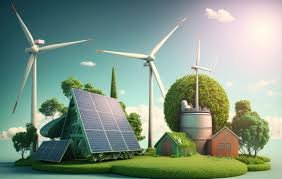Recent Advances and Their Impact on the Energy Sector in 2024
Introduction: The Push for Renewable Energy
In 2024, the renewable energy sector is witnessing unprecedented advancements as the world accelerates its transition towards sustainable energy sources. These breakthroughs in technology not only promise to enhance efficiency but also aim to address critical challenges such as energy storage, grid integration, and cost reduction. As nations and companies alike invest in innovative solutions, the landscape of global energy production and consumption is undergoing significant transformation.
Key Breakthroughs in Renewable Energy Technology
1. Next-Generation Solar Panels
Recent advancements in solar technology are revolutionizing the efficiency and application of photovoltaic systems. The introduction of perovskite solar cells represents a major leap forward. Perovskite materials have shown the potential to significantly increase energy conversion rates compared to traditional silicon-based cells. For example, Oxford PV has achieved perovskite-silicon tandem cells with efficiencies exceeding 30%, which is a substantial improvement over the typical 20% efficiency of conventional solar panels. These cells are also cheaper to produce and can be incorporated into a wider range of surfaces, from building-integrated photovoltaics to flexible solar fabrics.
2. Advances in Wind Turbine Technology
Wind energy technology has also seen notable progress, particularly with the development of offshore floating wind turbines. Unlike traditional fixed-bottom turbines, floating turbines can be deployed in deeper waters where wind speeds are higher and more consistent. Companies like Equinor and MHI Vestas are leading the way in this technology, with floating turbines capable of generating more power and operating in previously inaccessible locations. These innovations are expected to expand the potential of wind energy significantly, contributing to a more stable and reliable energy supply.
3. Enhanced Energy Storage Solutions
Energy storage remains a critical challenge for renewable energy integration. Recent advancements in solid-state batteries and flow batteries offer promising solutions. Solid-state batteries, such as those developed by QuantumScape, use a solid electrolyte instead of a liquid one, providing higher energy densities and greater safety. Flow batteries, like those from Redflow, use liquid electrolytes stored in external tanks, allowing for scalable and long-duration energy storage. These technologies address the intermittency of renewable energy sources by enabling more efficient storage and dispatch of energy.
4. Green Hydrogen Production
Green hydrogen, produced through the electrolysis of water using renewable energy, is gaining momentum as a clean fuel alternative. Recent innovations have led to more efficient and cost-effective electrolysis technologies. Companies like Nel Hydrogen and ITM Power are advancing electrolyzer technology to scale up green hydrogen production. Hydrogen has the potential to decarbonize hard-to-abate sectors, such as heavy industry and transportation, by serving as a versatile and clean energy carrier.
Impact on the Energy Sector
1. Reducing Dependence on Fossil Fuels
The advancements in renewable energy technology are playing a crucial role in reducing global dependence on fossil fuels. As renewable energy sources become more efficient and cost-effective, they are increasingly capable of meeting the energy demands traditionally satisfied by coal, oil, and natural gas. The International Energy Agency (IEA) reports that renewables are expected to account for nearly 90% of the increase in total power capacity worldwide by 2024, significantly diminishing the role of fossil fuels in the energy mix.
2. Enhancing Grid Resilience and Stability
The integration of advanced renewable technologies also contributes to grid resilience and stability. Improved energy storage solutions and distributed generation capabilities help balance supply and demand, reducing the risk of blackouts and enhancing grid reliability. For instance, the deployment of smart grids and advanced demand response systems allows for better management of renewable energy inputs, ensuring that fluctuations in supply do not disrupt overall grid stability.
3. Driving Economic Growth and Job Creation
The renewable energy sector is becoming a major driver of economic growth and job creation. The development and deployment of new technologies create opportunities for innovation, manufacturing, and installation. According to the International Renewable Energy Agency (IRENA), the renewable energy sector employed over 12 million people globally in 2023, with further growth anticipated as new technologies and projects come online.
4. Supporting Global Climate Goals
Breakthroughs in renewable energy technology are crucial for meeting global climate goals. The transition to cleaner energy sources is central to achieving the targets set by the Paris Agreement and mitigating the impacts of climate change. By increasing the share of renewables in the energy mix, nations can significantly reduce greenhouse gas emissions and move closer to their climate commitments.
Conclusion: A New Era for Renewable Energy
In summary, 2024 is witnessing significant breakthroughs in renewable energy technology that are reshaping the energy sector. Advances in solar and wind technology, energy storage solutions, and green hydrogen production are driving the transition to a more sustainable and resilient energy system. These innovations are not only reducing reliance on fossil fuels but also contributing to economic growth and global climate goals. As technology continues to evolve, the renewable energy sector is poised to play a central role in addressing the challenges of climate change and creating a more sustainable future.


